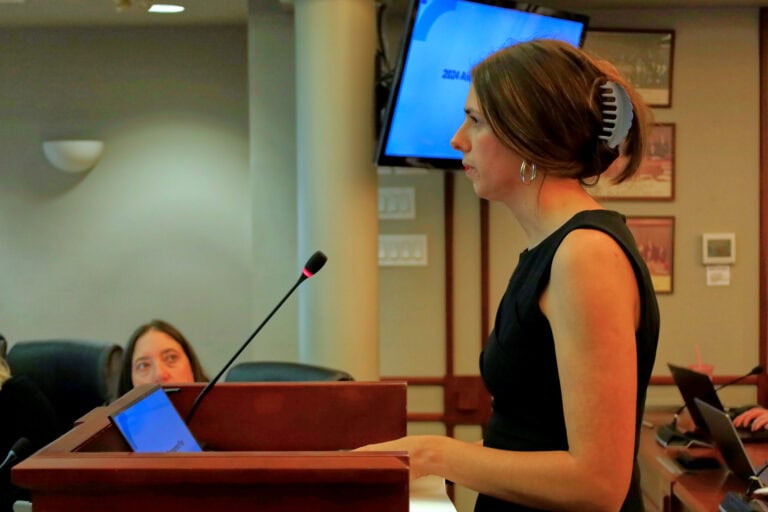Despite some revisions, residents voiced concerns Monday that the proposed apartment building at the old Parliament Oak school site is unacceptable in Old Town.
Liberty Sites Ltd. is developing the site and presented a revised proposal with several changes during a committee of the whole planning meeting. For starters, the number of apartments was reduced to 71 from 80.
The overall design also was changed so it progressively grows in storeys toward the centre of the building, making it less imposing where it borders residential streets but still reaching its full height of roughly 53 feet at its peak.
There also were some alterations to the proposed semi-detached and detached homes. Originally 12 homes were supposed to be built on the property. The developer reduced that to nine— four semi-detached and five single-storey residences.
No residents spoke out against the proposed construction of those nine homes on the plot. All criticism was focused around the large apartment building that is potentially going to be built along King Street.
“Let’s be clear what this really is,” Niagara-on-the-Lake resident Alan Gordon said during the open house.
“It’s a 40-foot-high apartment, over 300 feet long, currently containing 71 apartments. This, by any measure, is a massive building virtually an entire block long.”
“The visual impact of a 40-foot-high wall of apartments is reprehensible. It’s egregious.”
According to designs presented by the developer, the building actually reaches a total height of 16.4 metres, or some 53 feet, due to the inclusion of a penthouse walkout at the top.
The town’s official plan says building height should be limited to 36 feet.
Gordon said putting a building like this on King Street, which is one of the main arteries to Old Town, undermines the value of the historic district.
“It greatly diminishes the tone, style and certainly the attractiveness of the Old Town, which is why we get something like three-and-a-half million visitors a year to this place,” he said.
It wasn’t just the sheer size of the building compared to the one- or two-storey homes that surround it that had residents like Gordon up in arms. It was the proposed density and the perceived misinformation being floated regarding it.
Mark Iamarino, a planner with the town, said in his opening overview of the project the developer wants to have the land rezoned to medium-density residential.
Coun. Sandra O’Connor pointed out that the official plan allows the area around Parliament Oak to be rezoned to low-density residential only.
Iamarino clarified his remarks and said there would need to be an amendment to the town’s official plan to allow the construction to take place.
He also said the change to medium density would allow a “maximum net density of 23 units per acre.”
In actuality, NOTL’s official plan from 2017 defines medium density as 12 units per acre maximum net density.
This did not slip by Gordon.
“This would be 66 per cent greater than what’s allowed in medium density,” Gordon said. “And, it’s a whopping 233 per cent greater than the low-density surrounding neighbourhood.”
Gracia Janes, president of the Niagara-on-the-Lake Conservancy, also picked up on Iamarino’s comments and called the town out.
“I really do feel, without any bias on my part, that (town staff) seem to be biased. They seem to be promoting this,” Janes said.
Atis Bankas piled on.
“Listening (to the) details of the official plan, I wonder if the senior planner knows of those requirements,” Bankas said.
He questioned why a developer can even apply to build something that is not legal under the town’s official plan.
“It should be scrapped and thrown in the garbage. That’s it. If the builder wants to build, let him build a park or something else,” he said.
“I don’t think they will do that because there’s not a profit there.”
Bankas said approval of the project could set a bad precedent for the town and signal “the beginning of the destruction of this town.”
He asked what’s stopping a developer from buying two adjacent properties in Old Town, paying to have them rezoned as one and building whatever they want on the new property.
Janes said the developer was rushing the project along instead of trying to build something that would fit in with the surrounding neighbourhood.
“It’s not appropriate for this (area). It sticks out like a sore thumb. Beautiful as it is, it is very different, it’s very bulky and it’s very high,” she said.
Another contentious point was the argument presented by Iamarino and the developer that NOTL needs to meet intensification targets, which have been set by the region as 15 per cent.
“We’ve already met our target,” Janes said. “(The region) have said that we’ve met our target to 2052.”
Janes said planned developments in Glendale will provide housing for 16,000 people, far surpassing the growth rate of 15 per cent allotted to the town.
On top of that, the area where Parliament Oak sits is not actually even an intensification area, something O’Connor and Gordon noted.
“Staff are still going through the review,” Iamarino replied to O’Connor.
Janes pointed out that a previous council had rejected a large apartment proposal on Mary Street.
“I would ask council to follow the lead of staff and councillors when they turned down the apartment on Mary Street,” she said.
“That council, that staff, they listened to the public and they used the same Planning Act, they used the same provincial policy, regional policy and town’s official plan to say, ‘No.’ ”
Since the developer has supplied revised site plans Lord Mayor Betty Disero worked to ensure there would be another open house in the future for more resident input to be received.



.png)







